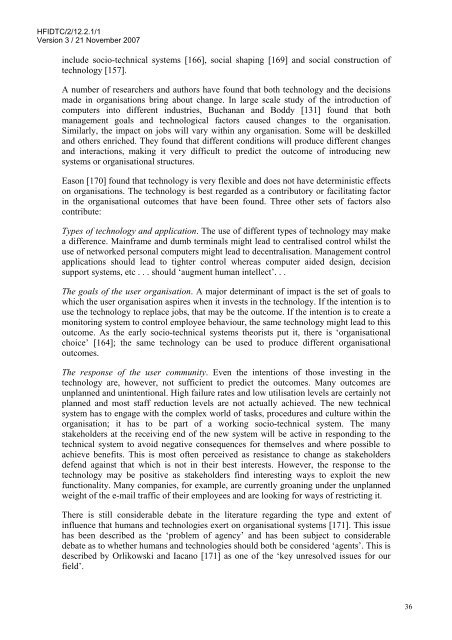The Impact of Technology Insertion on Organisations
The Impact of Technology Insertion on Organisations
The Impact of Technology Insertion on Organisations
You also want an ePaper? Increase the reach of your titles
YUMPU automatically turns print PDFs into web optimized ePapers that Google loves.
HFIDTC/2/12.2.1/1<br />
Versi<strong>on</strong> 3 / 21 November 2007<br />
include socio-technical systems [166], social shaping [169] and social c<strong>on</strong>structi<strong>on</strong> <str<strong>on</strong>g>of</str<strong>on</strong>g><br />
technology [157].<br />
A number <str<strong>on</strong>g>of</str<strong>on</strong>g> researchers and authors have found that both technology and the decisi<strong>on</strong>s<br />
made in organisati<strong>on</strong>s bring about change. In large scale study <str<strong>on</strong>g>of</str<strong>on</strong>g> the introducti<strong>on</strong> <str<strong>on</strong>g>of</str<strong>on</strong>g><br />
computers into different industries, Buchanan and Boddy [131] found that both<br />
management goals and technological factors caused changes to the organisati<strong>on</strong>.<br />
Similarly, the impact <strong>on</strong> jobs will vary within any organisati<strong>on</strong>. Some will be deskilled<br />
and others enriched. <str<strong>on</strong>g>The</str<strong>on</strong>g>y found that different c<strong>on</strong>diti<strong>on</strong>s will produce different changes<br />
and interacti<strong>on</strong>s, making it very difficult to predict the outcome <str<strong>on</strong>g>of</str<strong>on</strong>g> introducing new<br />
systems or organisati<strong>on</strong>al structures.<br />
Eas<strong>on</strong> [170] found that technology is very flexible and does not have deterministic effects<br />
<strong>on</strong> organisati<strong>on</strong>s. <str<strong>on</strong>g>The</str<strong>on</strong>g> technology is best regarded as a c<strong>on</strong>tributory or facilitating factor<br />
in the organisati<strong>on</strong>al outcomes that have been found. Three other sets <str<strong>on</strong>g>of</str<strong>on</strong>g> factors also<br />
c<strong>on</strong>tribute:<br />
Types <str<strong>on</strong>g>of</str<strong>on</strong>g> technology and applicati<strong>on</strong>. <str<strong>on</strong>g>The</str<strong>on</strong>g> use <str<strong>on</strong>g>of</str<strong>on</strong>g> different types <str<strong>on</strong>g>of</str<strong>on</strong>g> technology may make<br />
a difference. Mainframe and dumb terminals might lead to centralised c<strong>on</strong>trol whilst the<br />
use <str<strong>on</strong>g>of</str<strong>on</strong>g> networked pers<strong>on</strong>al computers might lead to decentralisati<strong>on</strong>. Management c<strong>on</strong>trol<br />
applicati<strong>on</strong>s should lead to tighter c<strong>on</strong>trol whereas computer aided design, decisi<strong>on</strong><br />
support systems, etc . . . should ‘augment human intellect’. . .<br />
<str<strong>on</strong>g>The</str<strong>on</strong>g> goals <str<strong>on</strong>g>of</str<strong>on</strong>g> the user organisati<strong>on</strong>. A major determinant <str<strong>on</strong>g>of</str<strong>on</strong>g> impact is the set <str<strong>on</strong>g>of</str<strong>on</strong>g> goals to<br />
which the user organisati<strong>on</strong> aspires when it invests in the technology. If the intenti<strong>on</strong> is to<br />
use the technology to replace jobs, that may be the outcome. If the intenti<strong>on</strong> is to create a<br />
m<strong>on</strong>itoring system to c<strong>on</strong>trol employee behaviour, the same technology might lead to this<br />
outcome. As the early socio-technical systems theorists put it, there is ‘organisati<strong>on</strong>al<br />
choice’ [164]; the same technology can be used to produce different organisati<strong>on</strong>al<br />
outcomes.<br />
<str<strong>on</strong>g>The</str<strong>on</strong>g> resp<strong>on</strong>se <str<strong>on</strong>g>of</str<strong>on</strong>g> the user community. Even the intenti<strong>on</strong>s <str<strong>on</strong>g>of</str<strong>on</strong>g> those investing in the<br />
technology are, however, not sufficient to predict the outcomes. Many outcomes are<br />
unplanned and unintenti<strong>on</strong>al. High failure rates and low utilisati<strong>on</strong> levels are certainly not<br />
planned and most staff reducti<strong>on</strong> levels are not actually achieved. <str<strong>on</strong>g>The</str<strong>on</strong>g> new technical<br />
system has to engage with the complex world <str<strong>on</strong>g>of</str<strong>on</strong>g> tasks, procedures and culture within the<br />
organisati<strong>on</strong>; it has to be part <str<strong>on</strong>g>of</str<strong>on</strong>g> a working socio-technical system. <str<strong>on</strong>g>The</str<strong>on</strong>g> many<br />
stakeholders at the receiving end <str<strong>on</strong>g>of</str<strong>on</strong>g> the new system will be active in resp<strong>on</strong>ding to the<br />
technical system to avoid negative c<strong>on</strong>sequences for themselves and where possible to<br />
achieve benefits. This is most <str<strong>on</strong>g>of</str<strong>on</strong>g>ten perceived as resistance to change as stakeholders<br />
defend against that which is not in their best interests. However, the resp<strong>on</strong>se to the<br />
technology may be positive as stakeholders find interesting ways to exploit the new<br />
functi<strong>on</strong>ality. Many companies, for example, are currently groaning under the unplanned<br />
weight <str<strong>on</strong>g>of</str<strong>on</strong>g> the e-mail traffic <str<strong>on</strong>g>of</str<strong>on</strong>g> their employees and are looking for ways <str<strong>on</strong>g>of</str<strong>on</strong>g> restricting it.<br />
<str<strong>on</strong>g>The</str<strong>on</strong>g>re is still c<strong>on</strong>siderable debate in the literature regarding the type and extent <str<strong>on</strong>g>of</str<strong>on</strong>g><br />
influence that humans and technologies exert <strong>on</strong> organisati<strong>on</strong>al systems [171]. This issue<br />
has been described as the ‘problem <str<strong>on</strong>g>of</str<strong>on</strong>g> agency’ and has been subject to c<strong>on</strong>siderable<br />
debate as to whether humans and technologies should both be c<strong>on</strong>sidered ‘agents’. This is<br />
described by Orlikowski and Iacano [171] as <strong>on</strong>e <str<strong>on</strong>g>of</str<strong>on</strong>g> the ‘key unresolved issues for our<br />
field’.<br />
36

















